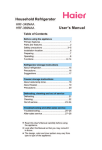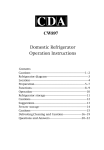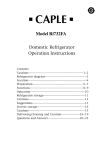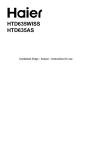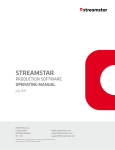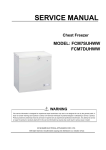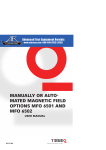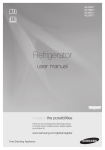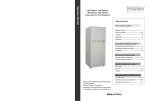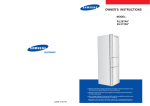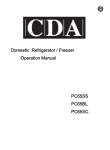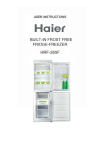Download Haier HRF-516FKA User's Manual
Transcript
HRF-516FKA Frost Free Refrigerator/Freezer Table of Contents Before using the appliance Primary features ....................Inside cover Diagram of parts ....................................1 Safety precautions .............................2-4 Location ................................................6 Preparation ...........................................6 Operation ..............................................7 Functions ..........................................8-11 Instructions for refrigerator storage Refrigerating storage compartment ........12 Refrigerating storage precautions ..........13 Suggestions .........................................14 Instructions for freezer storage Freezing storage compartment ...............15 Freezing storage precautions .................16 Defrosting, cleaning and vacation Defrosting ............................................17 Cleaning ..............................................17 Vacation ..........................................18-19 Troubleshooting and after-sales service Troubleshooting ..............................20-22 After-sales service ...........................23-24 Please read this operation manual carefully before using the appliance. Keep this manual properly for future reference. Appearance, color and layout of the door may vary. Primary features Programmed temperature control, refrigerator/freezer temperature display Fuzzy Mode The refrigerator regulates the cooling performance automatically according to inside and ambient temperature. Efficient ice making A semi-automatic icemaker is installed in the freezer compartment and ice cubes can be made efficiently. Unique chiller compartment design On the top of the refrigerator compartment is a chiller drawer designed for convenient access. Automatic defrosting This appliance features air-cooling system for automatic defrosting. Unique external layout Unique designs of streamline and curve refrigerator doors Built-in cooling system Clear back design with built-in condenser and compressor. Multiple venting system for efficient cooling achievements Multiple vents are designed in the air circulation channels for efficient distribution of coldness in each compartment. Diagram of parts Freezer compartment Ice maker Shelf Super freeze tray Light Refrigerator compartment Drawer chiller Dairy bin Shelf Light Bottle holder Crisper Crisper cover Power plug Decal sticker Dear customer, Thank you for your purchasing Haier product. Please read this manual carefully before using the electrical appliance that you have just purchased. Haier, sincere forever. Layout of the refrigerator that you have just purchased may vary due to technical improvement of this company. 1 Safety precautions This refrigerator requires a 220V/50Hz supply Failure in operation and damage to the control panel, thermostat or the compressor will occur if voltage is outside the range 187-242V unless a regulator with a capacity of over 750W or higher is installed. A separate earthed socket is required. The refrigerator is supplied with a standard three-pin plug, of which the one for grounding should never be removed. Plug of installed refrigerator shall be always accessible. Care for external cable *Hold the plug, not the electric cable, when unplugging the refrigerator. *Ensure that the electric cable is not trapped by the refrigerator. Do not step on the cable. *Avoid damage to the electric cable when moving the refrigerator. Damaged electric cable When the electrical cable is damaged or worn, turn off the refrigerator and consult to an authorized service agent for replacement. If inflammable gas leaks in the vicinity of the refrigerator *Turn off any leaking valve; *Open the doors and windows; *Do not, under any circumstances, unplug electrical appliances in the vicinity of the leak. Unplug the refrigerator for the following: *Cleaning or maintenance; *Replacement of lamp 2 Safety precautions This refrigerator should be used for food storage. It is not recommended to place microbiological or chemical materials, which have special requirement in temperature setting. Alkali Acid Gas Spray Mousse Never store inflammable, explosive or corrosive materials in the refrigerator. Bacterin Vaccine Chemical Agent 3 Do not install the refrigerator near gasoline or other inflammable articles. Don't place electrical plugs, regulators or microwaves on top of the refrigerator. Don't use electric appliances (Except those allowed by manufacturer) inside the refrigerator. Do not swing on or apply excessive pressure to the refrigerator door. Don't place heavy or unstable articles or water containers on top of the refrigerator. Safety precautions Do not touch inside surface of freezer compartment in operation, especially with wet hands as hands may freeze onto the surface. Do not spray or splash the refrigerator when cleaning the refrigerator, nor place the refrigerator in a damp area. Disassembly, renovation or cooling system maintenance of refrigerator must be authorized. Never store bottled beer or beverages in the freezer compartment. Unplug the refrigerator in the event of a power interruption or during cleaning. Allow at least 5 minutes lapse before restarting the refrigerator. Remove the refrigerator door and door seal if the refrigerator is discarded to prevent accidental entrapment in the refrigerator. 4 Location The freezer should be placed on a flat and solid surface and can be leveled by wedging a flat, strong and fire-resistant materials. Never use the foam packing material for leveling the freezer. The appliance can also be leveled by adjusting the front foot of the freezer with a dedicated or 22mm spanner provided by the manufacturer, clockwise for raising and anticlockwise for lowering. Anti-clockwise Adjustable foot Spanner The refrigerator shall be placed away from heat sources or direct sunlight. Clockwise The refrigerator should be placed in a well-ventilated area, and a space of 10cm or more should be allowed around the refrigerator. >10cm >10cm >10cm Never place the refrigerator near to a water source. Clean and dry any water splashes and stains with soft cloth. 5 Never place the refrigerator in an area with an ambient temperature below zero. Never operate the refrigerator outdoors or in rain. Preparation Unpacking Remove all packing materials. Check attached accessories and materials. Check if all accessories specified in the Packing List are available. Contact the local distributor if shortage is found. Operation Manual Warranty Certificate Remove the decal sticker from inside the refrigerator compartment and attach it as shown in the figure. Remove the handles and screws from inside the refrigerator compartment and install the handles to the doors as shown in the figure. Ensure that the refrigerator is properly located. (See section “Location”) Clean the refrigerator before using. (See section “Cleaning”) Time lapse before power supply Connect the refrigerator to power source at least 30 minutes after the refrigerator is sited and cleaned. Caution: After unpacking, write down the model and manufacture number of the refrigerator on the Warranty Certificate which will be required if technical services are applied for. 6 Operation Connection to power supply When the refrigerator is initially powered, the Fuzzy Mode is automatically activated, refrigerator and freezer temperatures are displayed; Super Freeze and Holiday modes are not activated so relative icons, snow flake and umbrella, are not displayed; Lock-off mode is activated, the Lock-on icon is not displayed. Because of high temperature in the freezer compartment, the freezer temperature indicator keeps blinking for alarm mode until a while later. Setting of operation mode Suggestion: Regardless of irrespective fluctuations in ambient temperature, selection of the Fuzzy Mode will guarantee the most efficient and energy-saving operation of the refrigerator. Either of the following operation modes can be selected. (1) Fuzzy Mode: In Lock-off mode, hold Freeze/Fuzzy Mode button pressed for 3 seconds until the Fuzzy Mode icon appears on the screen. (Refer to the section “Functions”) (2) Manual Mode: In Lock-off mode, press the Temperature button for temperature settings. (Refer to the section “Functions”) Loading the refrigerator with food When set temperature is reached, the freezer temperature icon will not blink any more, and food can be loaded in the refrigerator. Caution: Some time will be required for the refrigerator to reach the set level when the temperature is adjusted. The length of this period is determined by difference in the existing and set temperatures, the ambient temperature, the frequency with which the door is opened and closed and the amount of food in storage. 7 Functions Control panel A. B. C. D. E. F. Fuzzy Mode button Super Freeze button Refrigerator Temp button Freezer Temp button Fuzzy Mode icon Super Freeze icon G. H. I. J. K. Operation icon Refrigerator temp display Freezer temp display Holiday icon Lock-on icon Note: The block English letters in front of the phrases above listed will be used hereinafter to represent the phrases thereof. Lock-on and lock-off In Lock-off mode, press button A and B, icon K will light and Lock-on mode is activated. In Lock-on mode, if button A and B are pressed simultaneously, icon K goes out, the Lock-on mode is inactivated and the following modes can be set. Caution: The following functions , , , , and can be operated in lock-off mode (icon K off). 8 Functions Fuzzy Mode (This section can be skipped if Fuzzy Mode is set.) This mode is designed to ensure normal operation of the refrigerator under variable ambient temperature. Temperature in refrigerator compartments is automatically adjusted according to variations of ambient temperature. Press button A, figure E will appear on the screen and Fuzzy Mode is activated. If button A is pressed in Lock-on Mode, the Fuzzy Mode will be inactivated and icon E disappears. Refrigerator temperature adjusting (This section can be skipped if Fuzzy Mode is set.) In Lock-off mode, press button C, icon H will blink and refrigerator temperature can be set. Every press of button C will increase the refrigerator temperature by 1°C until 10°C is reached. If the same button is pressed again, the cycle will restart from 2°C. The temperature value will be confirmed 5 seconds after the final press, icon H will cease blinking and display the current refrigerator average. Freezer temperature adjusting (This section can be skipped if Fuzzy Mode is set.) In Lock-off mode, press button D, icon I will blink and freezer temperature can be set. Every press of button D will increase the freezer temperature by 1°C until -26°C is reached. If the same button is pressed again, the cycle will restart from -16°C. The temperature value will be confirmed 5 seconds after the final press, icon I will cease blinking and display the current freezer average. 9 Functions Refrigerator compartment on/off Hold button C pressed for 3 seconds, icon H will disappear and performance of refrigerator compressor will cease. Hold button C pressed for 3 seconds again, icon H will appear and performance of refrigerator compressor will be resumed. Super freeze (Super freeze mode cannot be set in Fuzzy Mode.) Super freeze function is designed to preserve food nutritional value as the food will freeze completely in the shortest period of time. Press button B, icon F will appear and the super freeze mode is activated. The super freeze mode can be manually inactivated by a press of button B and icon F will disappear. The super freeze mode will cease automatically after set working hours of compressor is reached. Holiday mode Hold button A pressed for 3 seconds, icon J appears and Holiday mode is activated. Displayed temperature of refrigerator and freezer compartments is 17°C and -18°C, respectively, and 3 second later, previous temperature display will recover and then the temperature will creep to 17°C and -18°C. In Holiday mode, refrigerator and freezer temperature cannot be adjusted. Holding button A pressed for 3 seconds again will inactivate the Holiday mode with icon J disappearing. 10 Functions Display control 30 seconds later after press of any button, the LCD backlight will go out. The LCD backlight will light when any button is pressed again. 10 Operating state display When icon G rotates, it indicates that the refrigerator is in operation. 11 Over temp warning I If the refrigerator temperature is above set value, icon I will blink. Verify if the refrigerator door is properly closed or a large portion of hot food is loaded. Icon I will cease blinking automatically after a while. Contact authorized after-sales service when necessary. 12 Power interruption memory The current operating mode can be resumed if the power supply is regained after a temporary interruption. 13 Defect display If sensors of the refrigerator do not work properly, icon H or I will display F1, F2, F3, F4 or F5 according to the nature of the problem. In such case, although the fridge does not cease operation, it is strongly suggested that an authorized agent for after-sales service be contacted. 11 Refrigerating storage compartment The refrigerator is for short-term food storage of daily consumption. Although the temperature in most areas in the refri geration compartment can be regulated between 0°C and 10°C, extended periods of food storage is not recommended. Refrigerator should only be used for shortterm storage. Storage areas As cold air circulates inside the refrigerator, temperature differences exist inside the storage compartments. Area is the coldest. Different foods should be placed in different areas according to their properties. Eggs, butter and milk Beverages and bottled food Canned food and seasonings Pickled food or canned pickled food Wheaten food, canned food, milk and bean curd Cooked meat and sausages Fruit, vegetables and salad Caution: Ensure that the door of the chiller compartment is closed before closing refrigerator door. Lamp and its replacement Lamp: 220-240V, 15W Lamp holder: E14 (lamps exceeding 15W Lamp cover must not be used) When replacing the lamp (freezer compartment to top figure; refrigerator µ ÆHole ÕÖ¿× compartment to the figure below), 1. Unplug to disconnect the power 2. Remove the food shelf in front of the lamp. Lug 3. Remove the freezer lampshade: Insert your index finger into the hole and slightly pull to remove the lampshade. (As shown in the figure) Remove the refrigerator lampshade: As Lamp cover shown in the figure. 4. Remove the lamp by turning anticlockwise and install a new lamp by turning it clockwise. 5. Properly install the lampshade after ensuring that all lugs on the cover are placed into the holes on the lamp holder. Lamp holder Lamp Lamp holder Lamp Slot 12 Refrigerating storage precautions Hot food must be cooled to room temperature before storing in the refrigerator. Food to be stored should be properly sealed. 13 Dry any water droplets on the food before placing it in the refrigerator. Storage of sorted food This will prevent moisture in the food from evaporating and prevent vegetables and fruit from tainting in flavor. Food to be stored should be sorted according to consumer requirements. Food consumed daily should be placed in the most convenient area, this will minimize opening periods for the door. Do not store excess quantities or weights of food Do not place food too close to the internal walls Food should be stored with spaces in between for better storage results. Never overload shelves, as they may collapse under excessive loads. Food with high moisture content should not be placed close to the walls of the inner liner. Maintain a space to prevent food from freezing onto the walls. Suggestions Leaves of carrots or turnips should be removed before storage. Eggs should be stored vertically in the egg holder. Frozen food can be placed in the cold compartment before serving, as this will conserve energy. Onions, garlic, ginger, water chestnuts and other root vegetables should not be stored in the refrigerator, as these foods are suitable for long-term storage at normal temperatures. Ripe squash, melon, pawpaw, bananas and pineapples should not be stored in the refrigerator. Freezing will accelerate the ripening process. 14 Freezing storage compartment Long-term storage of food As the freezer storage temperature is very low, fresh food can be stored in the freezer compartment for a long time. Food requiring long-term storage can be stored in the frozen food compartment. Follow the instructions on the package for storage period. Attention should be paid to the storage information printed on the food packing. Suggested storage period is as follows: Food Stay Best (Month) Maximum (Month) Chicken, beef, mutton and shrimps 4 9 Dumplings, ribs and ice-creams 4 6 Cakes, breads, sliced meat and cheese 2 6 Seafood, sausages and icecream 1 3 Storage period is subject to the detailed information on the food packing, property of the food for storage and special requirements. Super freeze Water level mark The food will freeze completely if it is placed on the super freeze tray. Ice cube making *Remove the ice cube tray. *Pour cold boiled water into the ice cube tray (Below the level mark, or ice cubes are not easily removed) *Replace the tray in the freezer compartment. *Turn clockwise the knob on front side of ice maker and then the ice cubes will drop into the ice cube box underneath. Ice cube tray Knob *Tilt a bit the front side of ice cube tray when removing it from the refrigerator. Ice cube box Caution: Ice cube tray cannot be used for making ice cubes or containing cheese, tea or soup to avoid cracks due to freezing. 15 Freezing storage precautions Hot food should not be stored in the refrigerator until it has cooled down to room temperature. Food cut into small portions will freeze faster and be easier to defrost and cook. The recommended weight for each portion is less than 2.5kg. The outside of any food packing should be dried before storage in the freezer, and any packing materials should be odor-free, airtight, non-poisonous and nontoxic. Food should be stored in accordance with any information printed on the packing. DMY Only remove the required amount of food from the freezer compartment. Defrosted food cannot be re-stored in the freezer unless it is first cooked. DM Y Do not load excessive quantity of fresh food in the freezer compartment. Quantity of the food in storage shall comply with the cooling capacity of the refrigerator. 16 Defrosting Automatic defrosting This refrigerator is designed for automatic defrosting. Cleaning The refrigerator should be cleaned regularly to prevent the formation of bad odors. Disconnect the power before cleaning the refrigerator. Clean the refrigerator with a soft cloth or sponge with mild detergent. Acide Det erg ent Gas Caution: Do not use a hard brush, steel brush, detergent, gasoline or other solvents, hot water, acid or alkali for cleaning. Dry water droplets on surfaces of the refrigerator with a piece of cloth. Caution: Do not use excessive amounts of water for cleaning the refrigerator. Use a dry cloth to clean the switch and the lamp. Regularly clean the surfaces of the external shell to improve the heat elimination efficiency. 17 Always keep the door gasket clean. Vacation Power interruption Even in summer, food can be stored in the refrigerator for a few hours after a power interruption. Don't put additional food into the refrigerator during a power interruption and try to open the door as less frequently as possible. If prior notice of a power interruption is given, make some ice and put it in a container in the top of the refrigeration compartment. Caution: Temperature in the refrigerator will rise as for a power interruption or technical problem, and the storage period will be reduced. Ceased operation If the refrigerator is to be ceased for an extended period, unplug the refrigerator and clean the refrigerator as previously described. Keep the door of refrigerator open when the power is turned off to prevent any food remaining in the compartment from producing bad odors. Caution: It is recommended that the refrigerator be not turned off unless it is necessary. Caution: Do not restart the refrigerator until a period of at least five minutes has elapsed. 18 Vacation Before leaving for a vacation If the vacation is short, remove vulnerable food from the refrigerator, set the Holiday Mode and make sure that the door of the refrigerator is properly closed. If the vacation is long, take out the food from the refrigerator and disconnect the power. Wait until the frost inside melts, clean and dry the compartment. Leave the door open to prevent formation of bad odor. Moving the refrigerator Unplug the refrigerator. Remove all the food. Secure the shelves in the cold storage compartment, vegetable and fruit tray and drawers in the freezer with tape. Tightly close and tape the door of the refrigerator. Do not tilt the refrigerator more than 45 degrees. Caution: Never place the refrigerator horizontally. 19 Troubleshooting The evaporator and piping system of the refrigerator may produce a slight sound when the refrigerator operates due to ambient temperature changes. The thermostat, starting capacitor and heat protector may produce a slight sound when the refrigerator starts or stops. Poop Clatter Poop Clatter A slight sound may be produced by defrosting water flowing into the evaporating recipient and the compressor at the moment of operation commencement or vacation. Click Click A slight continuous sound can be heard when the liquid refrigerant circulates to the evaporator. Swish Swish 20 Troubleshooting A slight sound may be heard when the appliance is first started. The sound will be lower and lower gradually a short period later. Temperature of the refrigerator and the compressor will rise and the compressor will run for comparatively longer periods when the refrigerator is first started. Hum Hum The fan of an operating refrigerator may produce a slight sound. The compressor will operate for comparatively longer periods if excessive quantity of food is stored or the ambient temperature is high. Whir Whir Water droplets may occur on outer surfaces and middle connection of the refrigerator due to heavy moisture in room air. Wipe clean with soft cloth. 21 The two sides of the external surface, bottom and the middle connection of the refrigerator will be warm due to heat radiation of the appliance. Troubleshooting Energy efficiency specified in the technical parameters complies with government standards and is measured under the following conditions: ambient temperature 25 ° C, refrigerator compartment temperature 5° C, freezer compartment temperature -18° C and 24h continuous operation with doors closed. Actual power consumption may exceed this value if more food in storage, ambient temperature higher and the door more frequently opened. Excessive vibration will result in the following circumstances: a)The refrigerator is not well positioned and adjusted. b)The refrigerator is placed on a wood floor or near to wooden furniture. Liquid refrigerant flowing in the evaporator may produce a slight sound similar to that of flowing water. When the refrigerator is stopped, the backflow refrigerant may also generate that sound. Swoosh Swoosh 22 After-sales service In the event that the refrigerator does not work properly, please check out and solve problems according to the following methods. If problems persist, contact the aftersales service center. Information of model, accessory list and serial number of the refrigerator is required. Please determine the cause of the problem before making any repair. The refrigerator does not operate. Disconnection to the power supply (plug, socket or fuse); Voltage is low; Lamp does not illuminate. The bulb is bad; Power supply is not connected. Automatic defrosting is activated. (Compressor ceases operation for 25 minutes) Excessive noise Contact between the Uneven placement. refrigerator and a wall or other article; Set temperature not reached. Door is not properly closed, or the door is opened for long period; 23 Refrigerator is in direct sunlight, or close to a heat source; The area is poorly ventilated, or the two sides of the refrigerator are covered by too much dust. After-sales service Please determine the cause of the problem before making any repair. Strange odor Failure to seal food properly Rotting food inside refrigerator Failure of regular cleaning of the refrigerator Prolonged operation period of the compressor Initial operation Large quantity of food loaded Hot weather Frequent opening of the refrigerator door Door not properly closed Improper temperature setting (see the section “Functions”) Poor ventilation 24


























